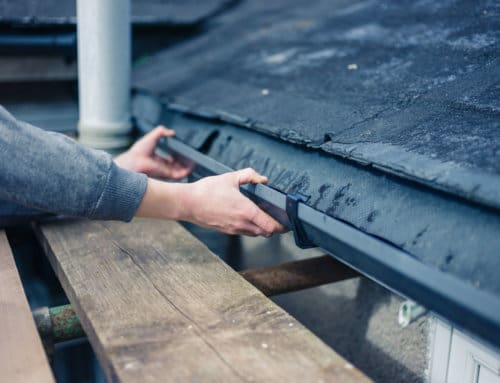Your home’s ability to channel water away from the foundation doesn’t just end abruptly at the downspouts. If this excess rainwater or snowmelt cascading off your roof isn’t being correctly routed to a better location, you could be looking at significant foundation repairs down the road. Thankfully, there are several preventive options that the homeowner can take to avoid these pitfalls:
Extensions For Downspouts
Providing you have enough slope at the downspouts drainpipe, you may be able to get by with just a splash block placed at the pipe outlet. This will suffice for most cases, but since practically every part of the country has at least one major storm event a year, the better solution is to attach a downspout extension pipe to carry the storm water at least 5 feet away from the house foundation. This should keep most of this excess water from creating potentially destructive puddles around your house.
Making the Grade

Downspout diverting water from the foundation
Having the proper ground slope away from your foundation is of vital importance when dealing with rain or snow runoff. Depending on the type of soil on your property, the slope around your home might require anywhere from a 5 percent grade for clay-based ground with limited absorption capabilities, all the way to a 10+ percent grade for sandy soils that entirely absorb water. All slopes should extend out a minimum of 10 feet from the foundation.
Trenches, Drains, and Wells
Even if your property has the proper slope away from the house, there is still the possibility of water pooling underground, and then eventually backing up against the foundation walls. This usually occurs after several days straight of heavy rain or snow that end up saturating the subsoil.
One way to address this extra groundwater is to dig a trench 3 to 4 feet deep, and 2 to 3 feet across, running the length of the lowest part of your yard. By using filter fabric and loose gravel covering the perforated pipe in the trench, you can efficiently keep this type of drain from clogging. As was the case with the downspout outlets, make sure you maintain at least a 5 percent slope over the length of the run. This is achieved by having the pipe drop approximately 6 inches for every 10 feet of length. If you find this to be impossible due to the amount of distance needed for your yard, then more drastic measures are called for, such as…
A dry well can be a great way to handle all the pooling and puddling water in your yard if you aren’t able to pipe it away. Dry wells are essentially water collection pits filled with gravel or crushed stone and dug to a predetermined depth to match your soil’s particular drainage characteristics. They can work wonders on small lots or areas of rugged, challenging terrain.
Excessive rainwater or snowmelt can certainly test the limits of even the most carefully installed downspout drainage system. If you happen to live in the Southern Oregon area and are experiencing any problem related to home gutters and downspouts, please don’t hesitate to contact Gutt-R-Done for a free estimate!






Leave A Comment